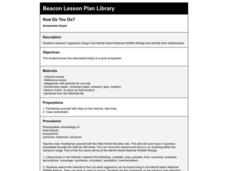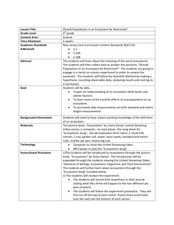Curated OER
Ecosystems
Your students will definitely understand what the word ecosystem means after viewing this slide show. The word ecosystem is broken down to its root meaning, described with examples, and then defined by the factors that comprise it. Note:...
Chicago Botanic Garden
Nature Walk and Ecosystem Introduction
A food web has no organism higher than a tertiary consumer because there wouldn't be enough energy left to sustain them. The fourth installment in a seven-part series begins with a nature walk to get pupils thinking about their...
Curated OER
Populations and Ecosystems
Sixth graders examine the factors that influence the stability of ecosystems. They construct a miniature ecosystem in a jar that includes plants, small fish, and snails, record the population changes over a period of four weeks, and...
Curated OER
How Do You Do?
Seventh graders research organisms in the Merritt Island National Wildlife Refuge. They create a picture book demonstrating their understanding of relationships.
Curated OER
Fire Ecology
Fourth graders examine the role fire plays in maintaining the physical factors of the scrub ecosystem. They see that world ecosystems are shaped by physical factors that limit their productivity.
NOAA
Community Ecology and Sampling
Seamounts in the Coral and Tasman Seas are home to more than 850 different species. Groups explore hydrothermal vents, researching the organisms found there and their energy source. They also learn about seamounts, exploring their unique...
Science Matters
Basic Needs
Scholars take part in a grand conversation about the basic needs of living things. Working collaboratively, pupils brainstorm and identify similarities to come to the conclusion that the environment meets the needs of all living things.
Curated OER
Should Populations in an Ecosystem be Restricted?
Fourth graders experiment to determine how overpopulation effects ecosystems specifically plants. In this ecosystem lesson, 4th graders conduct an ecosystems experiment after listening to Claire Daniel's, Ecosystems. They watch a video,...
Curated OER
Crustacean Critters
Young scholars explore the habitats of hermit crabs. In this crustacean lesson, students discover what animals need to survive. Working with live hermit crabs, young scholars explore how hermit crabs have adapted to their habitats.
Curated OER
Podcasting Crusader's Style
Students work as a group of scientists studying a specific biome of their choice. In this biome lesson, students research a biome and develop a podcast where factual information is read about a biome and the events of interest that make...
Curated OER
Habitat survival
Sixth graders study different environments and how the food chain affects the survival of different animals. In this environments lesson plan, 6th graders share the visuals which describe the characteristics of the environment that they...
Curated OER
Survivor
Seventh graders investigate changes in the ecosystem within the school year. They see that ecosystems, communities, populations, and organisms are dynamic and change over time. They, in groups, collect data in quadrants in the fall,...
ArtsNow
Arts Now Learning: Dramatic Living and Non Living [Pdf]
Students explore the differences between living and nonliving things through the lens of the nursery rhyme, "Hey Diddle Diddle." After bringing the characters to life, the students discuss the concepts of living and nonliving and act out...














![Arts Now Learning: Dramatic Living and Non Living [Pdf] Lesson Plan Arts Now Learning: Dramatic Living and Non Living [Pdf] Lesson Plan](https://d15y2dacu3jp90.cloudfront.net/images/attachment_defaults/resource/large/FPO-knovation.png)